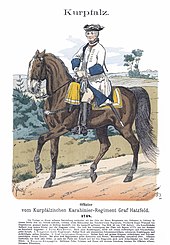Rittmaster

Rittmaster(German:Rittmeister,lit. 'riding/cavalry master')[1]is usually acommissioned officermilitary rankused in a few armies, usually equivalent toCaptain.Historically it has been usedGermany,Austria-Hungary,Scandinavia,and some other countries.
Arittmeisteris typically in charge of asquadron(acompany-sized unit called a "troop" in theUnited States,as opposed to the U.S. cavalry squadron of largerbattalionsize), and is the equivalent of aHauptmannrank (orcaptainin most army branches).[2][3]
Spelling
[edit]- Danish:ritmester
- Estonian:rittmeister
- German:Rittmeister(until 1951)
- Norwegian:rittmester(bokmål;the spellingritmesterwas used until 1907) orrittmeister(nynorsk)
- Swedish:ryttmästare
The armies of manyCentral and Eastern Europeancountries adopted a localised term for the similar rank.
- Czech:rotmistr
- Finnish:ratsumestari
- Lithuanian:rotmistras
- Polish:rotmistrz
- Russian:ротмистр,romanized:rotmistr
Czechia
[edit]The rank ofRotmistris an 'ensign' rank, used by both branches in theCzech Army.It is ranked OR-5 within theNATO rank structure.The immediate senior rank is calledNadrotmistr(lit. 'senior rittmaster') and is ranked OR-6.[4]
The Netherlands
[edit]The Dutch rankRitmeester,is the rank of squadron leading officers in thecavalryunits of theRoyal Netherlands Army.[5]
Norway
[edit]The Norwegian rank,Norwegian:rittmester/rittmeister,is the rank of officers in thearmouredandmechanized infantryunits of theNorwegian Army.The spellingritmesterwas used in Norwegian until 1907.
Historical use
[edit]In thePolish army(from the 15th century to the mid-20th century) arotmistrzcommanded a formation called arota.However, arotmistrzofhussarswas a commander of between 100 and 180 hussars, with a lieutenant of hussars as his second-in-command. The Lithuanian term wasrotmistras.[citation needed]In earlier times, therotmistrzserved as the commander of aninfantryorcavalrycompany,though sometimes he would temporarily be assigned field rank tasks e.g. commanding an entireregimentor even a larger formation. In the cavalry, the rank continued until 1945 as a company level title. Applied to the commander of atroop,it was equivalent of a modern-daycaptain.
The rank was also adopted byRussianNew Regimentsasrotmistr(ротмистр) and later formalized inTable of Ranksas the cavalry post; until 1798, and between 1883 and 1918, a lower-rankingshtabs-rotmistr(штабс-ротмистр) also existed, representing the ranks of Senior Captain and Junior Captain in the Russian Imperial Guards Cavalry, Army Cavalry, Gendarmerie and Border Guards by 1914.
In British and Commonwealth military forces, a Riding Master is not a rank. In theHousehold Cavalry Regimenta suitableWarrant Officerwith the rank ofRiding Instructorsis appointed Riding Master. The duration of this appointment is determined by the commanding Lieutenant-Colonel and, once appointed, the Riding Master is the person in the lead of training of recruits and horses of theHousehold Cavalry Regiment.[6]
NATO code
[edit]While the rank is used in some ofNATO countries,it is ranked differently depending on the country.
| NATO code | Country[7] | English equivalent | |
|---|---|---|---|
| UK | US | ||
| OF-2 | Netherlands, Norway | Captain | |
| OR-5 | Czech Republic | Sergeant | Sergeant |
Insignia
[edit]Current
[edit]Former
[edit]See also
[edit]References
[edit]- ^"Rittmaster".merriam-webster.
- ^The various names of this rank in different languages showGermanicetymology, (with a similar term used in Estonian). Thomas, Nigel; G. A. Embleton (2003).The German Army of World War I (1): 1914-15.Translated by G. A. Embleton.Osprey Publishing.ISBN9781841765655.Retrieved2008-10-16.[permanent dead link]
- ^
Jewison, Glenn; Jörg C. Steiner (2008-12-12)."Badges of Rank of the Austro-Hungarian Army 1914-1918".Austro-Hungarian Land Forces 1848-1918.Retrieved2008-10-16.
Infantry: Hauptmann... Cavalry: Rittmeister
- ^ab"Hodnosti".Army of the Czech Republic(in Czech).Retrieved11 August2024.
- ^ "Wie is wie- De rangonderscheidingstekens van de krijgsmacht (Who is who - rank insignia of military establishment)"(PDF).Directie Voorlichting en Communicatie(in Dutch). Ministerie van Defensie. October 2006. p. 2. Archived fromthe original(PDF)on 2007-10-30.Retrieved2008-10-16.
- ^"THE HOUSEHOLD CAVALRY - THE REGIMENTAL COMMAND STRUCTURE".Archived from the original on 2013-07-19.Retrieved2016-06-11.
{{cite web}}:CS1 maint: bot: original URL status unknown (link) - ^NATO(2021).STANAG 2116 NATO(7th ed.). Brussels, Belgium: NATO Standardization Agency. pp. D-1–D-3.
- ^"De rangonderscheidingstekens van de krijgsmacht"(PDF)(in Dutch). Ministry of Defence (Netherlands). 19 December 2016.Retrieved18 March2021.
- ^"Militære grader".forsvaret.no(in Norwegian). Norwegian Armed Forces. 4 February 2021.Retrieved26 May2021.
- ^Littlejohn, David (1985).Foreign Legions Of The Third Reich.San Jose: Bender Publishing. pp. 24–29.ISBN9780912138220.
- ^Václavíček, Ivo (2010)."Nový rok – nové hodnosti"(PDF).A Report: čtrnáctideník Ministerstva obrany ČR(in Czech). Vol. 3. Ministry of Defense of the Czech Republic. p. 41.ISSN1211-801X.Retrieved8 August2022.
- ^Hillmos, Finn."Hærens gradstegn 1923"[Army insignia 1923](PDF).chakoten.dk.Retrieved28 August2018.
- ^Henner, Sigurd; Böhler, Wolfgang (2013).Die deutsche Wehrmacht: Dienstgrade und Waffenfarben des Heeres 1939-1945[The German Wehrmacht: ranks and weapon colors of the army 1939-1945] (in German). Czech Republic: Motorbuch.ISBN978-3613036017.
- ^Mollo, Andrew(2001).The Armed Forces of World War II: Uniforms, Insignia & Organisation.Leicester: Silverdale books. p. 23.ISBN1-85605-603-1.
- ^Bunkley, Joel William (1918).Military And Naval Recognition Book: A Handbook On The Organization, Uniforms And Insignia Of Rank Of The World's Armed Forces(2nd ed.). New York: D. Van Nostrand Company. p. 203.Retrieved29 June2022.

![Rittmester (Norwegian Army)[9]](https://upload.wikimedia.org/wikipedia/commons/thumb/c/c1/Norway-army-OF-2.svg/57px-Norway-army-OF-2.svg.png)
![Rotmistr (Czechoslovak Army)[11]](https://upload.wikimedia.org/wikipedia/commons/thumb/c/c0/Czechoslovakia_Army_OR-6_-_%C5%A0t%C3%A1bn%C3%AD_Rotmistr_%281937-1939%29.gif/58px-Czechoslovakia_Army_OR-6_-_%C5%A0t%C3%A1bn%C3%AD_Rotmistr_%281937-1939%29.gif)
![Ротмистр Rotmistr (Imperial Russian Army)[15]](https://upload.wikimedia.org/wikipedia/commons/thumb/f/f9/1904ic-p05.png/51px-1904ic-p05.png)